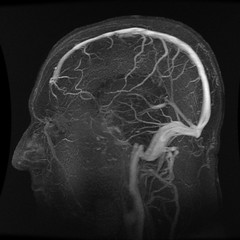(Sorry I've been inactive for the last week or so. I've been unable to blog or respond to e-mails because my computer fried. Just got it back up and running today, and let me just say that the Dell telephone service technicians are complete nincompoops. I think they mean well, but gadzooks, trying to diagnose a dead computer by reading through a script all the way in India just isn't working, folks. After I dig out from under a big pile of e-mails, I'll get back to posting my usual mindless dreck.)
 The Canadian Broadcasting Company aired a news piece tonight on CCSVI (the "vascular theory" of MS), which featured Dr. Zivadinov, the researcher who is running the imaging study at the University of Buffalo. This report is much more cautious than the feature that ran two weeks ago, and appears aimed at tempering the expectations of MS patients.
The Canadian Broadcasting Company aired a news piece tonight on CCSVI (the "vascular theory" of MS), which featured Dr. Zivadinov, the researcher who is running the imaging study at the University of Buffalo. This report is much more cautious than the feature that ran two weeks ago, and appears aimed at tempering the expectations of MS patients.
Just to throw in my two cents, I believe that CCSVI will in fact prove to play a part in the Multiple Sclerosis puzzle, but how big a part has yet to be determined. It may turn out to be the Holy Grail, or researchers might find that narrowed veins are the result of Multiple Sclerosis, and not the cause. The reality probably falls somewhere in between these two extremes.
Even if CCSVI does prove to play a major role in the MS disease process, it also must be determined exactly how best to treat it. As it stands now, the surgical treatments involve either balloon angioplasty, or placing stents in the narrowed sections of the jugular and/or azygos veins. Unfortunately, balloon angioplasty (referred to as the "Liberation Procedure") often has to be repeated, as 50% of the jugular veins treated eventually re-collapse. The stenting procedure has proven to have some major problems also, as the stenting of jugular veins is largely unexplored territory. One of the patients who was treated at Stanford University had a stent migrate down into his heart, necessitating emergency open-heart surgery to save his life.
It may turn out that customized procedures need to be developed to treat CCSVI, and multiple techniques will probably be necessary in order to address stenosis found in various places of the CNS venous system. In particular, stenosis very high up in the jugulars may prove to be quite problematic, resistant to both balloon angioplasty and stenting. Naturally, the stenosis that has been found in my jugular is extremely high up.
Yippie.
![Reblog this post [with Zemanta]](http://img.zemanta.com/reblog_e.png?x-id=1a6399ba-72c2-42d0-8954-fa7d56307ba7)
and here i was looking for a little good news today. the only good thing is all my finals are done.(yea)
ReplyDeleteim from the buffalo area and participated in the first round of reseach (1000 people) and had it
well you will be hearing hopefully from me in about a year on how well CCSVI works. the drugs are not doing as well as hoped for me and my neuro said im one of the first on her list as soon as it is approved or all the numbers are in.
pfrox 9
Thanks for the update - I do hope they figure out something around this soon. At least research is proceeding quickly. You're right - they need a different solution to treating it, also - the stenting thing is not ideal in that location. Too close to the heart. I think evaluating the adequacy of the collateral circulation needs to be done, also - proof of the reflux is key before intervention.
ReplyDeleteKeep wheelchair kamikaze-ing - you are an inspiration to me as I watch my legs becoming weaker. I'm saving up for a master scooter!
I am living in Japan, as you know the country of kamikaze.
ReplyDeleteI am sorry I could not understand the topic with my poor English skill.
But I hope the progress of medical reserch for you and for me.
The below is my website in progress about wheelchair and art.
http://homepage3.nifty.com/sekinoka-222/
Far from "mindless dreck" Marc.
ReplyDeleteIt is good to have a sobering view as this story/treatment progresses.
Thank you again,
-Scott